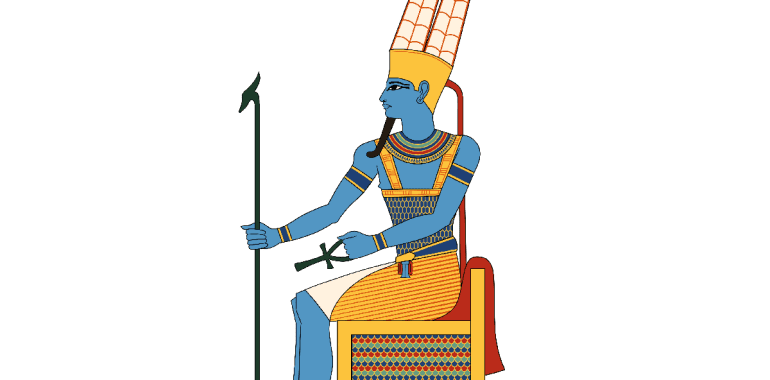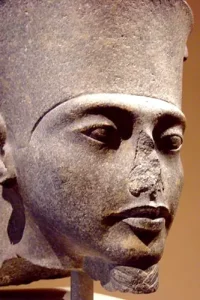
Revealing 5 Secrets of the Mighty Egyptian God Amun
In ancient Egyptian mythology, the Egyptian god Amun holds a place of immense significance. Revered as “The Hidden One,” Amun’s journey from a local deity to the king of the gods is a captivating story that reflects the complex nature of Egyptian religion and society. Let’s delve into the origins, evolution, and enduring legacy of the Egyptian god Amun.
The Origins of the Egyptian God Amun 
The Egyptian god Amun began his existence as a relatively minor deity associated with the air and wind in the city of Thebes, Upper Egypt. His name, meaning “hidden” or “invisible,” perfectly captures his elusive and intangible nature. Unlike gods linked to specific physical aspects of life, such as the Nile or the sun, Amun represented a hidden force that was omnipresent yet unseen.
Initially, Amun was just one of many local gods worshipped by the ancient Egyptians. However, as Thebes rose to prominence, so did Amun. His status as a deity would undergo a remarkable transformation.
The Rise of the Egyptian God Amun
Amun’s ascent began with the political and military success of Thebes. During the 11th Dynasty (around 2134–1991 BCE), Thebes emerged as a powerful city-state. The rulers of Thebes attributed their victories to the Egyptian god Amun, which significantly boosted his status. As Thebes grew in influence, so did Amun, and by the time of the Middle Kingdom (around 2055–1650 BCE), Amun was elevated to the rank of a national god.
Pharaohs began to see Amun as a divine protector and a symbol of their authority. They linked their successes and legitimacy to Amun, thereby reinforcing his central role in both religion and politics.
Amun and the Creation Myth
As the Egyptian god Amun became more prominent, his role in the creation myths expanded. He was eventually merged with Ra, the sun god, to form Amun-Ra, a deity with immense power. Amun-Ra was regarded as a creator god, responsible for the creation of the universe and all life within it.
In one version of the Egyptian creation myth, Amun-Ra is said to have created himself, an act that underscores his role as the ultimate source of all existence. This self-creation myth emphasized Amun’s supreme power and his integral connection to the concept of ma’at (truth and order).
Temples and Priests of the Egyptian God Amun
The worship of the Egyptian god Amun reached its zenith during the New Kingdom (1550–1070 BCE). The grandeur of Amun’s temples, such as the Temple of Karnak in Thebes, highlights his significant role in Egyptian religion. Karnak became the center of Amun’s worship, and its impressive complex still stands as one of the most magnificent historical sites today.
At Karnak, Amun was worshipped alongside his wife, Mut, and their son, Khonsu, forming the Theban Triad. This family of deities played a central role in the religious life of Thebes and underscored Amun’s importance within the pantheon of Egyptian gods.
The priests of Amun wielded considerable power and influence. As Amun’s worship grew, so did the wealth and authority of his priesthood. By the New Kingdom, the priests controlled vast lands and resources, sometimes even rivaling the pharaohs in power.
The Egyptian God Amun in Daily Life
While the Egyptian god Amun was closely associated with the elite and the pharaohs, he also held significance for ordinary Egyptians. Amun’s hidden nature made him a god that individuals could turn to for personal protection and guidance. Unlike deities tied to specific natural phenomena, Amun’s formlessness made him accessible to people from all walks of life.
In times of hardship or uncertainty, Egyptians would offer prayers and sacrifices to Amun, seeking his favor and intervention. Temples dedicated to Amun served as places where people could seek divine advice and support.
The Decline of Amun’s Influence
The prominence of the Egyptian god Amun faced a challenge during the reign of Pharaoh Akhenaten (1353–1336 BCE). Akhenaten’s religious reforms, known as the Amarna Period, sought to replace traditional polytheistic worship with the exclusive worship of the Aten, the sun disk. During this period, Amun’s temples were closed, and his priests lost much of their power.
However, Akhenaten’s reforms were short-lived. After his death, traditional religious practices were restored, and the worship of Amun resumed. Despite this restoration, Amun never regained the full extent of his previous dominance. Over time, other gods and religious ideas emerged, leading to a gradual decline in Amun’s influence.
The Legacy of the Egyptian God Amun
Though the Egyptian god Amun’s influence waned over the centuries, his legacy endures. The temples built in his honor, particularly the Temple of Karnak, remain as impressive monuments to his once-great power. These structures continue to attract visitors and scholars, providing a tangible connection to ancient Egyptian religion.
Amun’s dual nature as both a hidden and omnipresent force reflects the complexity of Egyptian spirituality. His story provides valuable insights into how the ancient Egyptians understood the world and their place within it.
Conclusion: The Hidden Power of Amun
The narrative of the Egyptian god Amun is one of transformation and enduring significance. From his modest beginnings as a local deity to his elevation as the king of the gods, Amun’s journey reflects the dynamic nature of ancient Egyptian religion. As a creator and protector, Amun played a crucial role in the lives of pharaohs and commoners alike.
Today, the legacy of Amun is preserved in the temples and monuments that stand as a testament to his once-great influence. Whether you’re a history enthusiast or simply curious about ancient Egypt, the story of Amun offers a fascinating glimpse into the spiritual and political life of one of the world’s most remarkable civilizations.

